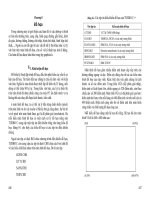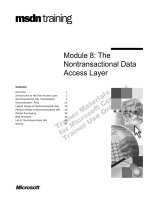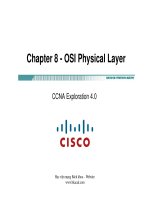Chương 8 - OSI Physical Layer doc
Bạn đang xem bản rút gọn của tài liệu. Xem và tải ngay bản đầy đủ của tài liệu tại đây (1.89 MB, 50 trang )
CCNA – Semester1
Chapter 8 - OSI Physical Layer
CCNA Exploration 4.0
Objectives
•
Explain the role of Physical layer protocols and
services in supporting communication across data
networks.
–
Describe the role of signals used to represent bits
as a frame is transported across the local media
•
Describe the purpose of Physical layer signaling and
encoding as they are used in networks
•
Identify the basic characteristics of copper, fiber and
wireless network media
•
Describe common uses of copper, fiber and wireless
network media
Communication signals
Physical Layer - Purpose
•
The OSI Physical layer provides the means to
transport across the network media the bits that make
up a Data Link layer frame.
Physical Layer - Purpose
•
Physical layer elements for delivering of frames:
–
A representation of bits on the media
–
Encoding of data and control information
–
Transmitter and receiver circuitry on the network
devices
–
The physical media and associated connectors
•
At this stage of the communication process, the user data
has been segmented by the Transport layer, placed into
packets by the Network layer, and further encapsulated as
frames by the Data Link layer. The purpose of the Physical
layer is to create the electrical, optical, or microwave signal
that represents the bits in each frame. These signals are
then sent on the media one at a time.
Physical Layer - Operation
•
There are three basic forms of network media on
which data is represented:
–
Copper cable
–
Fiber
–
Wireless
Physical Layer - Operation
•
Identifying a Frame
–
Encodes the bits into the signals for a particular medium
–
Distinguish where one frame ends and the next frame
begins.
•
The Physical layer may add its own signals to
indicate the beginning and end of the frame.
•
To the receiving device can clearly recognize a frame
boundary. These signals represent particular bit
patterns that are only used to denote the start or end
of a frame.
Physical Layer - Standards
The Physical layer technologies are defined by organizations such as:
The International Organization for Standardization (ISO)
The Institute of Electrical and Electronics Engineers (IEEE)
The American National Standards Institute (ANSI)
The International Telecommunication Union (ITU)
The Electronics Industry Alliance/Telecommunications Industry Association (EIA/TIA)
National telecommunications authorities such as the Federal Communication
Commission (FCC) in the USA.
Physical Layer - Standards
•
Four areas of the Physical layer standards:
–
Physical and electrical properties of the media
–
Mechanical properties (materials, dimensions, pinouts) of
the connectors
–
Bit representation by the signals (encoding)
–
Definition of control information signals
•
Hardware components such as network adapters (NICs),
interfaces and connectors, cable materials, and cable
designs are all specified in standards associated with the
Physical layer.
Physical Layer - Standards
Physical Layer Fundamental Principles
•
Three fundamental functions of the Physical layer:
–
The physical components
–
Data encoding
–
Signaling
Physical Layer Fundamental Principles
•
Encoding
–
Encode : A method of converting a stream of data bits into a predefined
“code”.
–
Code: group of bits used to provide a predictable pattern, can be
recognized by both the sender and the received.
–
Predictable patterns: distinguish data bits from control bits; provide
better media error detection.
–
Encoding methods provide codes for control purposes such as
identifying the beginning and end of a frame.
•
Signaling
–
The method of representing the bits is called the signaling method.
–
The Physical layer standards must define what type of signal represents
a "1" and a "0“ on the media. This can be as simple as a change in the
level of an electrical signal or optical pulse or a more complex signaling
method.
Physical Signaling and Encoding:
Representing Bits
Signaling Bits for the Media
•
The transmission of the frame across the media occurs as a
stream of bits sent one at a time. The Physical layer
represents each of the bits in the frame as a signal. Each
signal placed onto the media has a specific amount of time
to occupy the media. This is referred to as its bit time.
•
At the Physical layer of the receiving node, the signals are
converted back into bits. The bits are then examined for the
start of frame and end of frame bit patterns to determine that
a complete frame has been received. The Physical layer
then delivers all the bits of a frame to the Data Link layer.
•
Successful delivery of the bits requires some method of
synchronization between transmitter and receiver.
Signaling Bits for the Media
•
Bits are represented on the medium by changing one
or more of the following characteristics of a signal:
Amplitude, Frequency, Phase
Signaling Bits for the Media
•
Non Return to Zero (NRZ): the bit
stream is transmitted as a series of
voltage values
–
Logical 0: low voltage
–
Logical 1: high voltage
•
Suite for slow speed data links
•
Inefficient bandwidth, susceptible
to electromagnetic interference.
•
The boundaries between individual
bits can be lost when long strings
of 1s or 0s are transmitted
consecutively. In that case, no
voltage transitions are detectable
on the media. Therefore, the
receiving nodes do not have a
transition to use in resynchronizing
bit times with the transmitting
node.
Signaling Bits for the Media
•
Manchester Encoding: bit
values are represented
as voltage transitions.
– 1: low voltage to high
voltage
– 0: high voltage to low
voltage
•
One voltage transition
must occur in the middle
of each bit time.
•
Manchester Encoding is
employed by 10BaseT
Ethernet (Ethernet
running at 10 Megabits
per second).
Encoding – Grouping Bits
Encoding – Grouping Bits
Encoding – Grouping Bits
Code Groups
•
Code group is a consecutive sequence of code bits that are interpreted
and mapped as data bit patterns. For example, code bits 10101 could
represent the data bits 0011.
•
Code groups are often used as an intermediary encoding technique for
higher speed LAN technologies.
•
By transmitting symbols, the error detection capabilities and timing
synchronization between transmitting and receiving devices are
enhanced.
Advantages using code groups include:
•
Reducing bit level error
•
Limiting the effective energy transmitted into the media
•
Helping to distinguish data bits from control bits
•
Better media error detection
Encoding – Grouping Bits
•
Reducing Bit Level Errors
–
To detect a bit as a 0 or as a 1, the receiver must know how and
when to sample the signal on the media. This requires that the
timing between the receiver and transmitter be synchronized.
–
If too many 1s or 0s being transmitted on the media, the
synchronization may be lost and individual bit error can occur.
Code groups are designed so that the symbols force an ample
number of bit transitions to occur on the media to synchronize this
timing.
•
Limiting Energy Transmitted
–
In many code groups, the symbols ensure that the number of 1s
and 0s in a string of symbols are evenly balanced, called DC
balancing. This prevents excessive amounts of energy from being
injected into the media during transmission, thereby reducing the
interference radiated from the media. In many media signaling
methods, a logic level, for example a 1, is represented by the
presence of energy being sent into the media while the opposite
logic level, a 0, is represented as the absence of this energy.
Transmitting a long series of 1s could overheat the transmitting
laser and the photo diodes in the receiver, potentially causing
higher error rates.
Encoding – Grouping Bits
Distinguish Data from Control
•
The code groups have three types of symbols:
–
Data symbols - Symbols that represent the data of the frame as it is
passed down to the Physical layer.
–
Control symbols - Special codes injected by the Physical layer used to
control transmission. These include end-of-frame and idle media symbols.
–
Invalid symbols - Symbols that have patterns not allowed on the media.
The receipt of an invalid symbol indicates a frame error.
•
The symbols encoded onto the media are all unique. The symbols
representing the data being sent through the network have different bit
patterns than the symbols used for control. These differences allow the
Physical layer in the receiving node to immediately distinguish data from
control information.
Better Media Error Detection
–
In addition to the data symbols and control symbols, code groups contain
invalid symbols. These are the symbols that could create long series of 1s
or 0s on the media; therefore, they are not used by the transmitting node.
If a receiving node receives one of these patterns, the Physical layer can
determine that there has been an error in data reception.
Encoding – Grouping Bits
Data Carrying Capacity
•
Data transfer can be measured in three ways:
–
Bandwidth
–
Throughput
–
Goodput
Data Carrying Capacity









